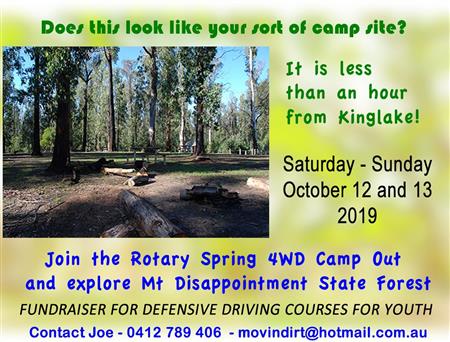RC of KINGLAKE RANGES ~ SPRING 4WD CAMP OUT
|
12 Oct 2019 |
||
|
Join our club for our Spring 4WD Tour of Mt Dissapointment State Forest
Bit of History of this POW Camp
Part 1of 3 -Camp No. 1- Mt. Disappointment State Forest- POW Camp
Camps No 1, 2 & 3 were set up in the Mount Disappointment State Forest during the later years of World War Two to house alien internees and later Italian prisoners-of-war.
No.1 Camp, known as the Broadford or Strath Alien Camp was situated at the intersection of Flowerdale, Allisons and Two Tees Roads.
Initially No.1 Camp housed Forests Commission staff until they were ordered to leave so that internees could be accommodated there. The Forests staff moved to Regular Camp, which is situated on the corner of Flowerdale and Main Mountain Roads. In May 1943 Camp No 1 was occupied by internees. By June 1944 the camp had been converted to house seventy five prisoners of war, and conformed to Geneva Convention standards.
The prisoners' labour was used for cutting firewood and forest maintenance. The camps came about because in 1943 the Australian War Cabinet approved a scheme to utilize Italian POW labour, in line with Geneva Convention guidelines. The Forests Commission was desperately short of manpower in the war years and took up the option of establishing work camps. The Army required the provision of one Pound per week per prisoner to provide food, tools and accommodation for both prisoners and army personnel. The Commission stated that it needed prisoners to work in four main areas: firewood production, fire protection work, road construction and pine plantation work.
During the latter years of World War Two, two sets of six charcoal kilns were established at Camp No 1, and in 1944 a powder magazine was constructed to store gelignite used in the construction of roads.
Five features of the original camp remain: a two-roomed corrugated iron building (explosives magazine) encircled by an earth mound (including log buttressing); two concrete slab foundations of previous buildings; a drain/water race; and a cement water storage tank.
Detainees and POWs were not locked in and had a free range of the vicinity of the camps. It was said that there were signs several hundred yards away on the roads leading out of the camp that stated “NO DETAINEES PAST THIS POINT.” However, inmates were known to visit down to Reedy Creek to request handouts and at Camp number 4 they would often make their way into Wallan.
Mr. C. Pavey, the Mt. Disappointment regional forester for the Commission wrote this regarding a success, if any regarding the scheme:
Vermin in the form of wombats, wallabies, wild dogs etc. had decreased and Pavey contributed the success to the reduction in “pests” to the Italians liking for meat. (Contrary to the Defence Department that stated that Italians did not require much meat).
300 prisoners were allocated to the Forestry Commission for the Kinglake and Broadford camps. Initial plans were for 3 camps at Broadford and 5 for Mt. Disappointment, as well as many in the Healesville and Kinglake areas.
A second camp was known as No. 2 Camp or Reedy Creek Camp (now Bambara). It was taken over by the army and enlarged and converted into a POW camp designed to hold 150 prisoners. By October 1944 it was occupied by prisoners who were to be put to work in the forests. Like No. 1 Camp, this camp also featured two sets of six charcoal burners, of which there are no remains. The school camp Bambara situated on the site was totally destroyed on Black Saturday in 2009.




